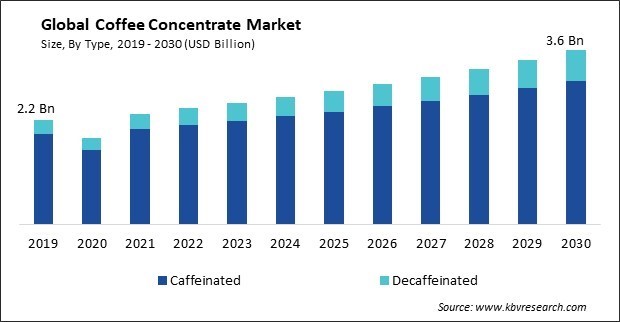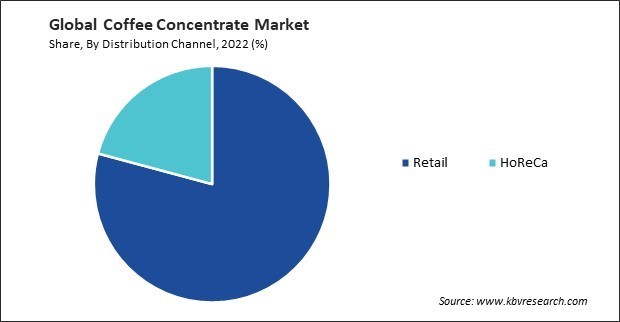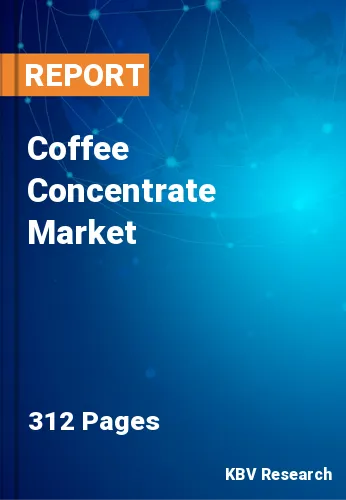“Global Coffee Concentrate Market to reach a market value of USD 3.6 Billion by 2030 growing at a CAGR of 5.3%”
The Global Coffee Concentrate Market size is expected to reach $3.6 billion by 2030, rising at a market growth of 5.3% CAGR during the forecast period. In the year 2022, the market attained a volume of 73,245.8 thousand litres, experiencing a growth of 5.1% (2019-2022).
Supermarkets and hypermarkets offer a vast and diverse range of products, making them ideal for showcasing different varieties and brands of coffee concentrates. Therefore, the supermarkets/hypermarkets segment captured $848.7 million revenue in the market in 2022. This extensive product accessibility exposes consumers to various choices within the market. Supermarkets and hypermarkets often allocate prominent shelf space to popular and innovative products. Brands of these can benefit from increased visibility within these stores, leading to higher chances of consumer recognition and purchase.

These concentrates with a long shelf life offer consumers the convenience of having a coffee solution available anytime. This convenience aligns with modern lifestyles, where consumers seek on-the-go and instant options. The extended shelf life allows for a longer period of product availability. Consumers can purchase these in larger quantities without the concern of rapid expiration, ensuring a steady supply of their preferred coffee product. Furthermore, a longer shelf life reduces the risk of product spoilage and wastage. Consumers can buy these in bulk without worrying about the product expiring quickly, contributing to cost savings and minimizing environmental impact. Additionally, these offer instant preparation, eliminating the need for time-consuming brewing processes. Individuals can efficiently prepare coffee by saturating the concentrate with hot water, offering a practical resolution for those with hectic schedules. The fast-paced nature of modern life has increased the demand for on-the-go food and beverage options. These cater to this trend by providing a portable and easily consumable coffee solution, allowing consumers to enjoy their favorite beverage while commuting or traveling. Furthermore, traditional brewing methods, such as drip brewing or espresso, can be time-consuming. Hence, convenience and time efficiency are driving the growth of the market.
However, traditional coffee brewing methods like drip or espresso have a long history and established consumer preferences. Consumers may be accustomed to the ritualistic and familiar aspects of traditional brewing, making it challenging for these to displace these ingrained habits. Some consumers associate the traditional brewing process with a higher perceived quality and authenticity in their coffee experience. The aroma, ritual, and sensory aspects of freshly brewed coffee contribute to a sense of tradition and may be perceived as superior to the convenience of coffee concentrates. Furthermore, coffee brewing methods often have cultural and regional significance. Certain cultures or regions may have strong ties to specific brewing traditions, making it challenging for these to gain widespread acceptance and adoption in these areas. Thus, competition from traditional coffee brewing methods is posing a hindrance to the growth of the market.
Based on type, the market is bifurcated into caffeinated and decaffeinated. The decaffeinated segment registered a considerable revenue share in the market in 2022. The decaffeinated products is used in baking to infuse coffee flavor into goods like decaffeinated coffee cakes, cookies, and muffins. It contributes to the overall richness of the product without the presence of caffeine. In creating desserts such as decaf ice creams, decaf mousses, and decaf custards, decaffeinated product imparts a concentrated decaf coffee flavor, allowing consumers to enjoy dessert without the stimulation of caffeine.
On the basis of distribution channel, the market is segmented into HoReCa and retail. The retail segment recorded the largest revenue share in the market in 2022. The retail segment plays a central role in shaping the market by ensuring market accessibility, offering diverse product options, and influencing consumer behavior through strategic merchandising and promotional initiatives. The impact of the retail segment is instrumental in driving the growth and demand of the market.

The retail segment is subdivided into supermarkets/hypermarkets, specialty stores, convenience stores, and online. The online segment acquired a substantial revenue share in the market in 2022. Global accessibility, convenience, diverse product offerings, and the integration of e-commerce trends characterize the rising impact of the online segment on the market. Brands strategically leveraging online channels can tap into a broader consumer base, adapt to changing market dynamics, and foster sustained growth in the competitive landscape.
Free Valuable Insights: Global Coffee Concentrate Market size to reach USD 3.6 Billion by 2030
Region-wise, the market is analyzed across North America, Europe, Asia Pacific, and LAMEA. The Europe region witnessed the maximum revenue share in the market in 2022. Europe has a rich coffee culture with a strong tradition of coffee consumption. The emergence of specialty coffee trends and a growing appreciation for diverse coffee experiences have created a favorable environment for accepting and adopting coffee concentrates. The use of these in Europe reflects the region's dynamic and evolving coffee culture, where consumers appreciate tradition and innovation in their coffee experiences.
| Report Attribute | Details |
|---|---|
| Market size value in 2022 | USD 2.4 Billion |
| Market size forecast in 2030 | USD 3.6 Billion |
| Base Year | 2022 |
| Historical Period | 2019 to 2021 |
| Forecast Period | 2023 to 2030 |
| Revenue Growth Rate | CAGR of 5.3% from 2023 to 2030 |
| Quantitative Data | Volume in Thousand Litres, Revenue in USD Billion, and CAGR from 2019 to 2030 |
| Number of Pages | 312 |
| Number of Tables | 670 |
| Report coverage | Market Trends, Revenue Estimation and Forecast, Segmentation Analysis, Regional and Country Breakdown, Porter’s 5 Forces Analysis, Company Profiling, Companies Strategic Developments, SWOT Analysis, Winning Imperatives |
| Segments covered | Type, Distribution Channel, Region |
| Country scope |
|
| Companies Included | Javy Coffee LLC, The J.M Smucker Company, Starbucks Corporation, Westrock Coffee Company Nestle S.A, Climpson & Sons, MONIN, Grady's Cold Brew, The Kraft Heinz Company, PepsiCo, Inc |
By Type (Volume, Thousand Litres, USD Billion, 2019-2030)
By Distribution Channel (Volume, Thousand Litres, USD Billion, 2019-2030)
By Geography (Volume, Thousand Litres, USD Billion, 2019-2030)
The Market size is projected to reach USD 3.6 billion by 2030.
Longer shelf life of coffee concentrates are driving the Market in coming years, however, Competition from traditional coffee brewing restraints the growth of the Market.
Javy Coffee LLC, The J.M Smucker Company, Starbucks Corporation, Westrock Coffee Company Nestle S.A, Climpson & Sons, MONIN, Grady's Cold Brew, The Kraft Heinz Company, PepsiCo, Inc
In the year 2022, the market attained a volume of 73,245.8 thousand litres, experiencing a growth of 5.1% (2019-2022).
The Caffeinated segment is generating the highest revenue in the Market, By Type in 2022; there by, achieving a market value of $3.0 Billion by 2030.
The Europe region dominated the Market, By Region in 2022, and would continue to be a dominant market till 2030; there by, achieving a market value of $1.2 Billion by 2030.
Our team of dedicated experts can provide you with attractive expansion opportunities for your business.

 Drivers
Drivers
 Restraints
Restraints
 Opportunities
Opportunities
 Challenges
Challenges
